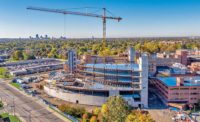Some 57 years before New York City-based Urbahn Architects was named ENR New York’s Design Firm of the Year, Martin D. “Marty” Stein made two decisions when working for NASA on Apollo mission facilities at Cape Canaveral, Fla.—to leave a little space below the floors and to have the tunnel concrete blocks underneath placed on their sides with the holes uncovered.
Stein, hired by company founder Maximillian Otto Urbahn in 1962 to work on the facilities and now the firm’s principal, was showing his tendency to design projects that remain useful—as proved when he got a phone call from the project manager for what is now the space agency’s Mars 2020 mission.
According to Stein, “She said, ‘Thank you! We didn’t know there was space under the floors!’ and I responded ‘Yeah, we [made both changes] so that in the future you could run wiring,’” Stein recalls. The anecdote exemplifies Urbahn: design that maximizes longevity, usefulness and—as their work on New York City’s subway stations and New York state’s juvenile corrections facilities last year shows—quality of life.
“We’re really involved in what a very liberal city is doing to reinvent itself.”
– Marty Stein, Principal Architect, Urbahn
“In the ‘90s … we shifted focus to take [contracts] with the “maximum possible impact on the most number of individuals,” says Rafael Stein, Marty’s son and a firm principal. During this decade, the rest of Urbahn’s leadership rose into place: Donald E. Henry Jr., managing principal; Natale V. Barranco, principal; and Ranabir Sengupta, associate principal.
That decade is also when the firm, established in 1945, became a regional leader in justice and transportation facilities. The architects’ work in those sectors, as well as in education, stood out in Urbahn’s Top Design Firms survey results.
The company has been part of the Metropolitan Transit Authority’s Fast Forward initiative to make subway stations accessible to riders with physical disabilities. It also has designed redevelopments of two city juvenile detention centers and has helped create educational spaces —ranging from so-called 3PK schools that serve 3-year-old pre-prekindergarten students to college facilities for SUNY and Columbia University, among others.
“We’re really involved in what a very liberal city is doing to reinvent itself,” says Marty Stein. “We’re the vehicle of creating a better place.”
In New York City, making subway stations more accessible and easier to traverse is key to improving quality of life for the greatest number of citizens. Fast Forward aims to “completely modernize” city transit and to make accessible the 75% of stations that currently are not. Urbahn is developing feasibility studies for 73 of the system’s 472 stops; different firms are doing parallel work on others. The Steins and their colleagues have already done reports on 40 of their assigned locales. Once everything is finished, MTA will decide which stations are the highest priority to work on first.
“[The studies] are very conceptual,” Barranco says, with consultants like Urbahn surveying stations, boarding platforms and the surrounding community at each stop. “The primary goal is to get a handicapped person to the platform in a manner consistent with able-bodied riders,” without prohibitive costs or a negative impact to the people who live or work around a station, he says.
To install elevators or ramps might require acquisition of additional property, Barranco explains. And there are obstacles to building them: Digging might hit electrical transformers or gas lines and elevated platforms could clutter the street. The team suggests innovative solutions like having turnstiles at the ground level with an elevator that takes riders directly to the platform.
Urbahn also has practical experience in subway station engineering; in the early 2000s, it designed the renovated 96th Street Station on the 1-2-3 Upper West Side line, which required the project team to widen Broadway and make space for the headhouse on the median.
“It was all beautiful granite, landscaping, two elevators, staircases down to the platform—a pretty intricate job while keeping the station open,” recalls Gary Yerganian, chief operating officer of Citnalta Construction Corp., part of the team that built the station.
Yerganian has high praise for Urbahn over another joint subway project—renovations of stations including the one on 53rd Street in Brooklyn on the R line, which opened in fall 2017, under MTA’s Enhanced Station Initiative.
He cites “the coordination of all the disciplines on their side, planning out the design, what was needed next, then executing. They were a real partner … and helped the construction team to see what was happening.” The station redos were fast-track jobs, taking just 11 or 12 months, which created extra pressure to stay on schedule because stops were completely shut to the public for about two months.
“These guys were at the glass fabricating shop to make sure these things were being made properly,” Yerganian says. “The partners there know everything that’s going on and are involved with it; they don’t just hand it off to someone.”
Urbahn’s penchant for renovation extends to government buildings, including Jersey City, N.J.’s new municipal service complex—created from an old warehouse and now home to police, fire and EMS units—and juvenile detention centers in New York.
Because of the Raise-the-Age law signed by Gov. Andrew Cuomo in 2017, which mandates that incarcerated youths younger than 18 be removed from adult jails, there was a rush to move juvenile offenders from the Riker’s Island detention facility in Queens. The Horizons and Crossroads juvenile detention centers—in the Bronx and Brooklyn, respectively, and both operated by the NYC Administration for Children's Services—originally were built around 1990 but were outdated.
“Juvenile justice has changed,” Henry explains. “In the ’80s and ’90s there were programs for education but not for psychological or mental [issues]. The whole point [now] is to counsel kids to find a better way. Old [facilities] didn’t provide for that level of therapeutic care.”
Additionally, the original buildings were constructed during a financial crisis, making fixes especially challenging.
“We could not put an addition on top—the structure wasn’t sturdy enough. The walls needed to be hardened, but the building couldn’t support” additional material, Henry says, adding that the firm employed “innovative uses of stud positions and reinforced steel to solve problems without overloading the structure.”
Urbahn and the project partners—including Mayor Bill de Blasio's Office of Operations and Office of Criminal Justice, the city’s Dept. of Design and Construction and construction manager LiRo—planned design and execution so well that the detention centers were finished four days early, on Oct. 1.
Urbahn says the centers are one reason for its big leap in revenue; transit renovations are another. The firm reported total regional revenue of $21.25 million for 2018, up 68.6% from $12.64 million in 2016, according to Top Design Firm surveys for those years. (The firm, which is in 44th place on the current ranking, did not participate in the 2017 survey.)
The juvenile projects cost $85 million for all work; correspondingly, the correctional sector made up $4.7 million of Urbahn’s revenue. Transportation accounted for $6 million of revenue. The firm expects to maintain growth; last fall, it moved to a larger 14,000-sq-ft office.
In the education design sector, Urbahn is taking advantage of de Blasio’s push for expanded toddler pre-K program facilities.
“These facilities are most typically leased by the Department of Education from private landlords [and] must be adapted to unique circumstances,” Rafael Stein says. In commercial storefronts, his team used mylar film to create privacy while allowing light and adding whimsical color. A current 3PK project, Stein says, requires turning two abutting buildings into a single facility, requiring interconnection while maintaining fire separation.
“The partners know everything that’s going on and are involved with it; they don’t just hand it off.”
– Gary Yerganian, Chief Operating Officer, Citnalta Construction Corp.
In Jersey City, the firm also designed an addition to BelovED Community Charter School System’s building, adding 23,000 sq ft in classrooms, gyms, art and music rooms, and other spaces to the existing 34,000 sq ft that Urbahn had designed in 1999. BeloveED consultant Bret Schundler, the city’s ex-mayor and a former state Dept. of Education commissioner, says the charter school was so pleased, it hired Urbahn to design another building across the street, which will have parking on the ground and three floors above.
Schundler says he was most impressed with the price of Urbahn’s services as well as its economical design. The addition cost $5.6 million, including architecture fees, with the new building set to cost about $15 million with land acquisition.
“Charter schools have much less funding than the public. So architects have to be sensitive to that and focus on [creating] a very cost-efficient space,” he says.
Along with higher education projects, such as the new School of Business at Farmingdale State College/ SUNY on Long Island, the education design sector generated more than $6 million in 2018 revenue.
Urbahn is “a very innovative firm,” says David Pinto, managing principal of Vanderweil Engineers, which worked on that $18.5-million project with Urbahn. “The buildings are high performing both in architecture and engineering. It’s holistic and integrated design for the entire complex, not just narrow-minded for each solution. People feel it’s a living building.”
Residential work also is a growing niche, with Urbahn set to have maximum impact on some 200 families in the Rockaways section of Queens. That’s the approximate number of units planned at The Tides, a mixed-use complex including market-rate apartments that is a small part of the 120-acre planned community Arverne by the Sea, which is designed to be resilient against hurricanes and rising sea levels.
The Tides, which will also have 135,000 sq ft of retail and restaurant space, will be higher density than other parts of the community, which is being developed by a Beechwood Organization-Benjamin Cos. joint venture.
“Building after Sandy has its complexities,” says senior project manager Gerald Romski. For example, the entire Arverne community was raised an average of 8 feet using fill dirt, putting the site well above the 100-year floodplain.
“Piles had to be up to 80 feet deep,” he adds, and “the foundation system had to be designed to comply with seismic events.”
The Tides buildings—the first was completed last year and the second is currently under construction—have been built with panelized assemblies put together off site and shipped to the site ready to be fastened to the substructure. This not only sped up erection and reduced material waste, it also was conducive to the units’ unique layouts, which all include protruding bay windows so that, says Sengupta, who designed the buildings, “Every unit can have an ocean view.”
Current rents at The Tides range from $2,000 for a studio to $3,150 for a 3-bedroom unit, according to Apartments.com.
The architecture firm’s process and design knowledge and skill are broad and deep, observers say. Rick Zotolla, partner at engineering firm Lera, who has worked with the firm’s leadership for about 20 years on many New York agency projects, notes that “Urbahn has a broad client base [and is] skilled at navigating the special requirements of agencies ... and building enduring trust.
“Clients return to them time and again,” he says.












Post a comment to this article
Report Abusive Comment